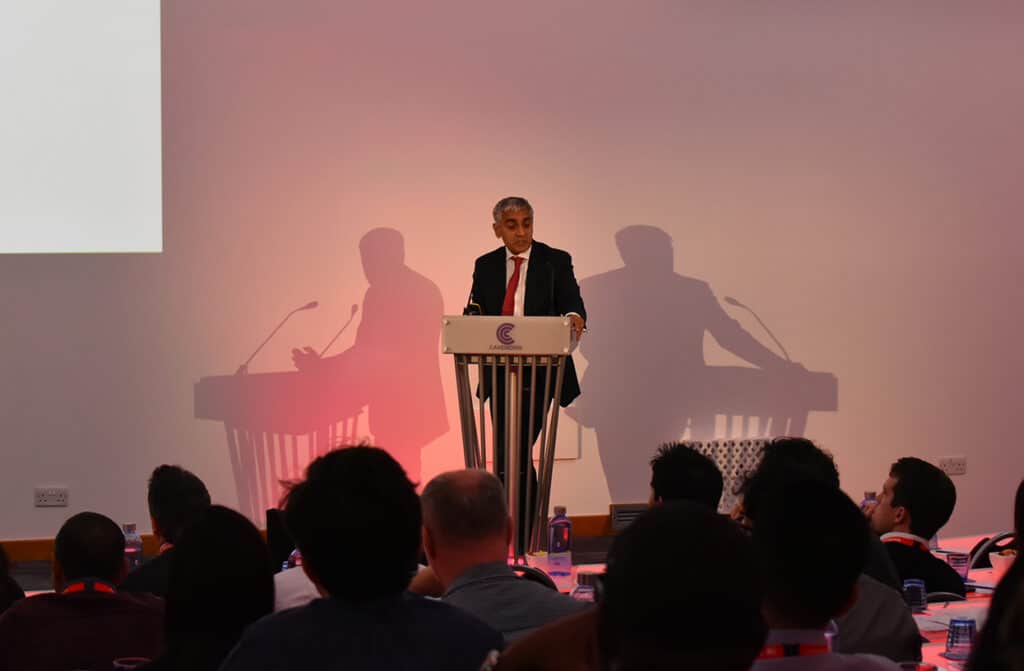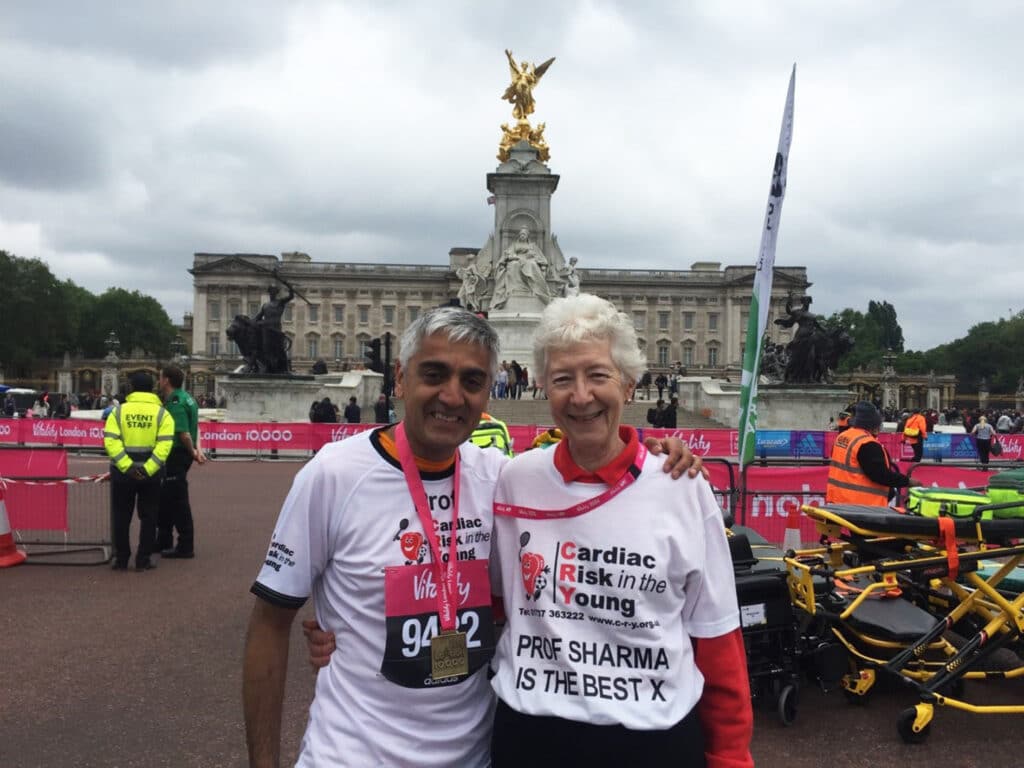By Alison Cox, from issue 82 of the CRY Update magazine.
I finally confirmed that Sanjay was not your average person when he told me – during a discussion we were having on reminiscing – that he started writing his thoughts and experiences down when he was four. He was a serious, curious child and wanted to know about and remember everything. He already had decided to be a doctor – there seemed to be so many of his relatives getting ill and he was fascinated by the doctors all coming and going and able to make them better – he saw doctors as some sort of miracle people and determined he wanted to be able to do miracles too. From the age of four it never occurred to Sanjay to ever be anything else but a doctor.
His parents had met and married in the U.K. but decided, under pressure from his uncle, to return to Uganda which had just got its independence. Their standard of living rocketed and they enjoyed a beautiful house, servants and nannies. Most of all he thrived on the private education afforded them. He delighted in reading, learning, and discovering challenging new opportunities. At primary school the teacher recognised his ability and put him in the class above to better stimulate his appetite for learning.
The family returned to the U.K. just before General Idi Amin expelled all Asians out of Uganda. Sanjay was about to have his eighth birthday and remembered the stark contrast clearly. Their accommodation became a bedsit above a butcher’s shop in Walthamstow; he struggled to understand the cockney accents of the local junior school children, and they could not resist cruelly taunting him and his two sisters. He missed the security of an extended family close by. It was so rainy and cold. Adjusting was hard work and life took its time to slowly start improving. However – because of Idi Amin’s eviction of Ugandan Asians – his grandparents arrived and he and his siblings greatly benefited from their love and understanding as their parents worked hard to support them.

Both parents had been educated in the U.K. and his father soon settled into a job as an administrator in the NHS whilst his mother became a Citizen Advisor. They were delighted by now to have been able to move to North London where the teachers at Sanjay’s local secondary school were quickly alerted to his academic ability. His aunt and uncle had both been head teachers at primary schools in Uganda, so education had always been impressed on them as a critical part of their lives, and working hard at junior school was a natural thing to do. By the time he went to secondary school there was an expectation that he would do well. And he did for a while until the third year when he started enjoying the distraction of an attractive social life. He lapsed into lazy indifference and persuaded himself ‘just getting by’ was ok. His wake-up call came just in time when his O Level results proved only marginally good enough to be permitted to sit his choice of A Levels.
He did not have to be reminded that ‘just sitting’ his exams was insufficient. Securing high grades were the only opportunity he would have to enter medical school. His headmaster was confident, however, and Sanjay consequently achieved the correct predictions from his tutors who then encouraged him to enter medical school.
Sanjay’s school did not have a reputation for high grades and his teachers kindly advised him not to be disappointed if he found he had not been able to secure a place in medical school because he would be confronting significant competition from the country’s top universities. As the A Level exams drew closer Sanjay became increasingly aware that the opportunity of doing what he had always dreamed of lay in his hands. That only he could now take it away. Sanjay’s mother had trained as a nurse at Leeds Hospital and spoke fondly of it in his childhood, so he was delighted when he learnt that he had been selected by Leeds medical school! On their first day the students were given a brutal introductory talk by the Dean, informing them that 20% of the intake would be expelled within 12 months for unsatisfactory progress. Sanjay immediately became concerned he might struggle, but in fact found that he loved every aspect of medicine ranging from the basic sciences to the clinical aspects of several sub-specialities. He was greatly relieved to finally learn that he had qualified with three distinctions, as well as obtaining the ambitious BSC degree in biochemistry in relation to medicine which he had included in his studies.
After working as a junior doctor at 3 major hospitals he decided to specialise in cardiology because cardiovascular disease was the biggest killer in the western world and he knew there had been several exciting advances in the management when he was a junior doctor. There were a number of outstanding opportunities produced for him at this crucial time that were unforgettable. His clinical mentor Dr Hackett contacted world expert Professor Bill McKenna when he found Sanjay wanted to specialise in hypertrophic cardiomyopathy, and he subsequently secured a place as a Research Fellow at St George’s Hospital. He had determined athletes would be his particular specialty and again fortune fell in his pathway (and mine!) when his ‘Prof’ introduced us. I had just started CRY with the ambition of creating a screening programme that would initially be limited to young athletes but would expand to all young people between 14 and 35. We fought several (often bloody!) battles together thereafter promoting screening, which soon became an established part of British sport.
Another huge development was when the Medical Director of the London Marathon, Dan Tunstall Pedoe, asked him to be his deputy with a view to Sanjay taking over 3 years later in 2007. Things seemed to happen very quickly after that! Sanjay was promoted to Consultant Cardiologist at Lewisham Hospital, became CRY’s cardiologist for our screening programme, and developed CRY’s research team. This provided the opportunity to not only gain supervision skills, but also crucially achieve multiple high quality publications in major cardiac journals. Sanjay compounded his rapidly developing reputation when, age 44, he became the Professor for Inherited Cardiac Disease and Sports Cardiology at St George’s Hospital. His research, sometimes tackled at midnight when the house was quiet, quickly gained an international reputation and currently is responsible for 20 major publications annually. Perhaps his most revealing quality is exposed in how much he values having developed an established teaching course for the Membership of the Royal Colleges of Physicians of the United Kingdom, which became the largest in the world and during the period of 1994-2017 assisted over 7,000 young people to pass their exam.
As the weather edges away from sunshine and towards its drab, bleak preparations for the winter months ahead, I look back on my 25 years with CRY considering the person who has quietly had the most impact and for the longest time… It was 1996 and Sanjay had just arrived at St George’s. I was looking for an opportunity to get CRY into the news and secured a desperate, but fully funded (!) two day trip to Jersey to raise awareness of Gambor, an orangutan at Jersey Zoo that suffered from hypertrophic cardiomyopathy and was attracting national attention after fathering a precious off-spring due to a newly tried medication.

I did not know Sanjay but he suddenly contacted me after learning of my prospective trip, and courteously requested whether he and his wife could join me as she was very keen to visit Jersey Zoo! And those two days contributed more to how I got to know Sanjay than any other later experience. We were both committed to our ‘day jobs’ but the unusual distraction of a highly publicised orangutan, who Sanjay was requested to examine and coolly accepted as a VIP patient, is what I believe gave me an extra dimension in understanding him and so contributed to developing the friendship that has bound us.
Sanjay’s unique talent is not only to be extraordinarily capable of doing three things at the same time, but most importantly stay loyal to his beginnings, not be seduced by glamour, and be sensitive to the difficulties of others less clever than himself!
Professor Sharma is the head of research for the cardiology clinical academic group at St George’s, University of London. In addition to being the director of the largest sports cardiology unit in the UK and overseeing CRY’s screening programme, he’s served as the Medical Director for the London Marathon since 2007 and the Medical Director for Prudential RideLondon since 2015. In 2012, he was the lead cardiologist for the London Olympics. He’s been involved in countless pieces of influential research and has over 250 PubMed citations. This includes highlights such as a special piece on cardiac screening in young athletes he wrote for the Journal of the American Medical Association in 2015; the ground-breaking international recommendations for the interpretation of ECGs published in the European Heart Journal and Journal of the American College of Cardiology in 2017, which helped transform the way we carry out screenings; and a paper in the New England Journal of Medicine in 2018, showing that the incidence of sudden cardiac death in footballers is higher than anticipated and ECG screening is essential in detecting underlying conditions.





